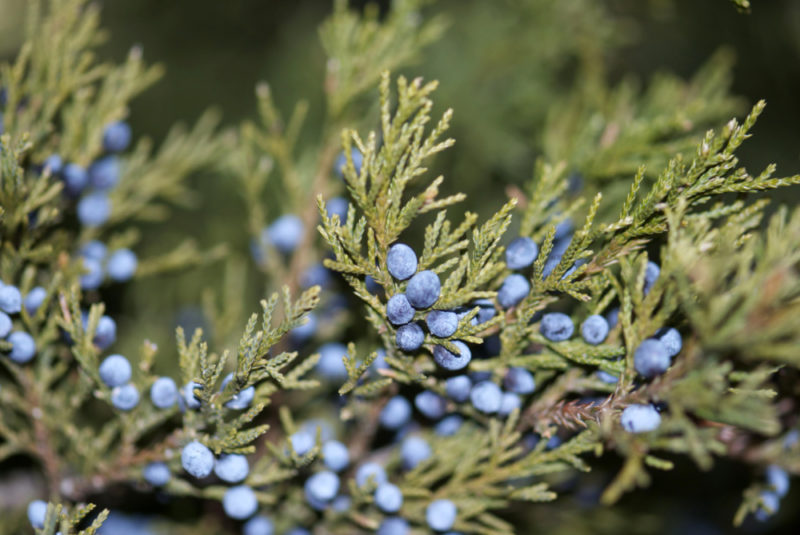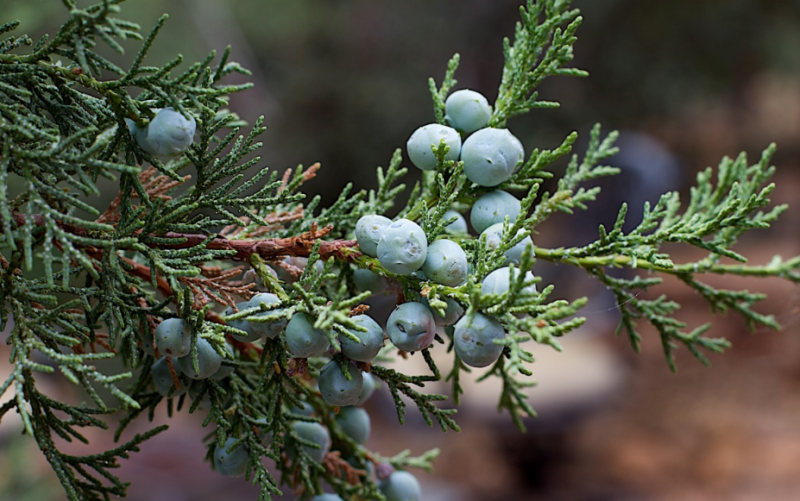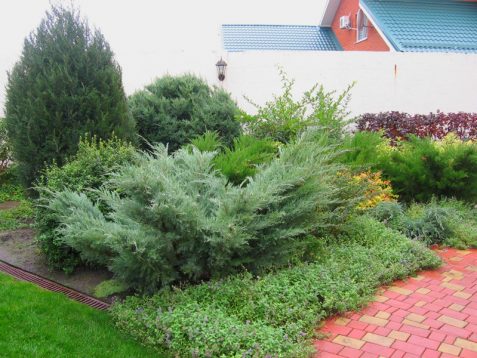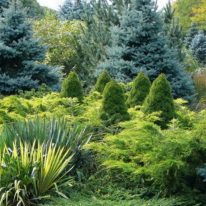In Russia, Virginia juniper began to grow as a decorative culture about 200 years ago. During this time, many interesting varieties appeared that inherited the main advantage of a wild ancestor - unpretentiousness and endurance.
Material Content:
Description of virgin juniper
In nature, juniper (Juniperus virginiana) is a tree up to 30 m high with a powerful trunk. Originally from North America. It occurs in the mountains along the coast of rivers and the ocean, on dry, non-nutritious soils. Hybrid forms that were obtained as a result of the work of breeders are distinguished by the geometry of the crown, the color of the needles.
Description of some varieties:
- "Gray Oul" - has a bluish-gray, elegant needles, grows in a large bush up to 2 m in height and 5 m in width;
- "Glauka" is a columnar form with bluish-green needles; in 10 years it grows to 3.5 meters in height;
- “Skyrocket” - the crown of an adult plant has a pectoral shape, the needles are gray-blue;
- “Hetz” - a dense crown requires regular pruning, the height of the plant by 10 years is 1.7 m, diameter 2 m, the color of the needles is blue-green with a grayish tint.
Young junipers are not inferior in decorativeness to other conifers. By the age of 40, tall specimens become less attractive, due to the exposure of the lower part of the trunk.
Outdoor landing
Juniper planting has its own characteristics.
- The hole for him should be deep, about 50 cm for a small seedling.
- It is advisable to pour a loose nutrient mixture from peat of neutral acidity, compost and earth into the planting pit.
- At the bottom, you can put a hydrogel (3 l) or drainage, it all depends on the characteristics of the landing site.
- If several plants are planted in a group to make a hedge, a small distance is left between the holes, about 1.5 meters.
Junipers are recommended to be placed in the sun, so that they show their best qualities, grow even, with a dense crown.
At first, the hydrogel will protect the root system from drying out. It is important to place the seedling in the pit at the same level as in the container. The root neck cannot be buried in the soil, it can rot. Transplanting container culture into open ground, the earthen lump around the roots is not destroyed in order to preserve mycorrhiza.
After planting, the well is watered and mulched. In winter, the trunk circle must be covered with needles or peat, in order to prevent freezing.
Agrotechnics of cultivation and care
After carefully reading the description of the species, you can understand that the virgin junipers are perfect for a low-maintenance garden. They do not require much attention: drought-resistant, shade-tolerant, rarely sick, tolerate pruning and keep the shape of the crown for a long time. They grow on any soil, do not need frequent top dressing.
Junipers respond with gratitude to care and care, like all plants.
- They grow better on loam or medium moist chernozem.
- When the weather is dry in summer, sprinkling on the crown in the evening is useful once every 7 days.
- Frequent watering is not required, it is good enough to shed the trunk circle 3 times per season.
- Loosen the soil after watering should be shallow, so as not to damage the roots.
- Mulching the land with peat or sawdust is carried out immediately after planting and before winter.
- Junipers are fed a complex fertilizer for conifers in the spring. You can use nitroammofosku (30 g / m2).
Weeding weeds, inspection of the crown, preventive spraying with chemicals from pests and diseases is carried out as necessary.
Breeding methods
Juniper is well propagated by seeds and vegetatively by cuttings and layering. Cultivars can only be propagated vegetatively.
Annual shoots are selected for cuttings, they can be harvested throughout the year, even in winter.
- Break off with your hands, leaving at the end a piece of wood, a small "heel".
- Rooted cuttings in containers with drainage holes, filling them with a loose mixture of sand and garden soil or peat.
- Then the substrate is moistened and the seedlings are covered with a cropped plastic bottle or a transparent plastic bag. The key to good rooting is almost 100% humidity under cover.
- A greenhouse needs to be aired daily for 10 minutes so that mold does not form.
- Put the cuttings on the diffuse lighting, the windowsill of the northern window is suitable.
- The air temperature must be at least 20 ° C.
Rooted seedlings are cultivated for 2 years, and only then planted in open ground, creating a landscape design of the garden.
Pest and Disease Control
With improper care, juniper can become a source of disease for fruit trees. Rust mushrooms, which cause “swelling” of the bark on the shoots, have a complex development cycle. At first, the spores ripen on the infected juniper, then are transferred downwind to an apple or pear, causing great harm.
If foci of sporulation appear on the conifer, diseased branches are cut out and burned, the remaining plant is treated with fungicide (Ridomil Gold, Tilt, Vectra, Skor).
Most coniferous plant pests bypass junipers, but there are dangerous insects and ticks that can cause harm:
- juniper aphids;
- European Juniper Scale;
- juniper moth;
- mealybug;
- Oregon flat-bodied tick;
- marble crunch.
Plants infected with insects are sprayed with insecticides: Aktara, Confidor, Calypso. The treatment with “Aktelikom” helps with ticks, with “Komandor”, “Bombardir”, and “Zhukomor” they use it from Khrushch.
Landscaping Ideas
Ornamental juniper growing in the garden is pruned, creating the necessary shape and size. Topiary craftsmen can give the shrubs the shape of a ball, cube, cylinder and even an animal.
The plant is used as a tapeworm in single plantings, in coniferous and mixed groups. It looks beautiful at any time of the year. In autumn, it is decorated with dark blue cone berries.
In winter, some varieties change color, for example, Virginia Juniper “Gray Oul” with bluish needles turns purple at the ends of the shoots, and the crown of “Glauka” takes on a purple hue.
So that snow does not break off thin branches of columnar specimens, their crown is wrapped with twine in a spiral from autumn.
Virgin junipers are distinguished by a variety of forms and ease of care. With their help, any gardener with imagination can decorate the garden.


















